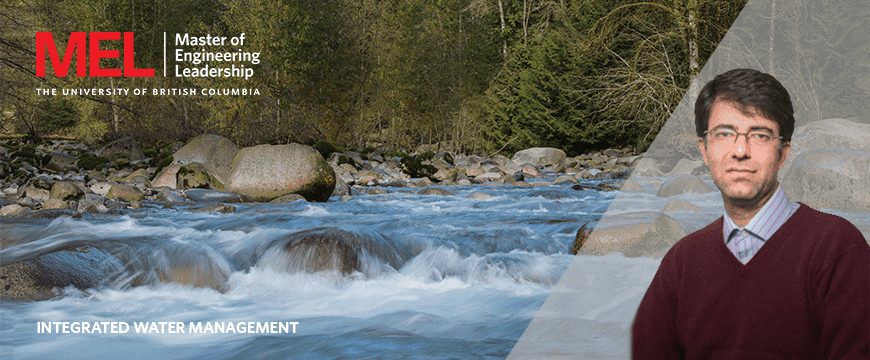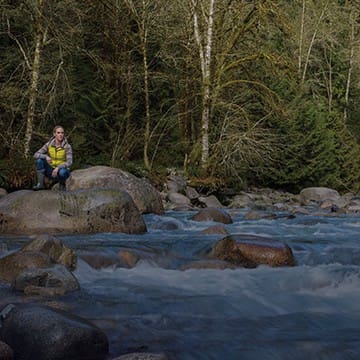Research Opportunities within the MEL Degree

The MEL degree supports students in their research interests while studying within the programs. A recently graduated student, Shahram Yarmand, published three papers during their studies that have real-world impact and relevance.
Students studying within the Master of Engineering Leadership (MEL) degree have opportunities to enrich their experience and pursue research interests of their own. The multidisciplinary and integrated nature of the programs provide the resources for students to seek support from world-class faculty and apply their skill sets to practical work with an impact. Shahram Yarmand, a student who has just finished their studies in the MEL in Integrated Water Management program, has taken the opportunity to publish three papers while studying within the MEL degree.
Yarmand’s research spans from optimizing drinking water in Vancouver to modeling the future of crude oil and bottled water prices. This research has real-world application and far reaching impact within the water sector. The nature of the MEL degree programs are such that these kind of self-initiated projects are highly encouraged and enabled through the structure of the program. Beyond the coursework, students are supported in their own research interests and there is room to produce important work during one’s studies. Yarmand’s work is an exemplary insight into what’s possible while studying within the MEL.
Abstracts of Yarmand’s papers:
Water Transfer Project from Tajikistan to Iran and Iranian Oil and Gas from Iran to Tajikistan
This case study discusses a water transfer project from Tajikistan to Iran in exchange for a transfer project of Iranian oil and gas from Iran to Tajikistan. The initial cost of the project is estimated at about 6 Billion US dollar to build a 600 km pipeline to supply water, oil, and gas. The construction of the project is estimated to take four years. Although Tajikistan and Iran have agreed to initiate the project, other countries in the Aral Sea basin did not support this project. The two main problems are the political aspects around geographical conditions of the countries around the Aral Sea basin and the business model of the international water trading. Geographically, the Aral Sea basin covers an extensive area of Central Asia, Tajikistan, Turkmenistan, Uzbekistan, Kyrgyzstan, Kazakhstan, Afghanistan, and Iran. Perlman, Veilleux, Zentner, and Wolf (2012) argue that there is a substantial risk to water security and a conflict between all basin users since the countries have been developing initiatives for agriculture and industry. However, Iran prepared a business model for water trading as well as oil and gas trading. The main idea put forward in this case study is that in addition to assessing hydropolitcal vulnerability and resilience in the basin we also need to analyze the mutual benefits of trading water in exchange for oil and gas.
To Estimate and Optimize the Source of Drinking Water for Metro Vancouver until 2040
The population of Metro Vancouver (20110729Regional Growth Strategy Projections Population, Housing, and Employment 2006 – 2041 File) will have increased greatly by 2040, and finding a new source of reservoirs for drinking water (2015_ Water Consumption_ Statistics File) will be essential. This issue of drinking water needs to be optimized and estimated (Data Mining file) with the aim of developing the region. Three current sources of water reservoirs for Metro Vancouver are Capilano, Seymour, and Coquitlam, in which the treated water is being supplied to the customer. The linear optimization (LP) model (Optimization, Sensitivity Report File) illustrates the amount of drinking water for each reservoir and region. In fact, the B.C. government has a specific strategy for the growing population till 2040, which leads them toward their goal. In addition, another factor is the new water source for drinking water that needs to be estimated and monitored to anticipate the feasible water source (wells) until 2040. As such, the government will have to make a decision on how much groundwater is used. The goal of the project is two steps: (1) an optimization model for three water reservoirs, and (2) estimating the new source of water to 2040. Read full paper here.
Replication data for Stochastic and Deterministic Modeling of the Future Price of Crude oil and Bottled Water
Deterministic and stochastic are two methods for modeling of crude oil and bottled water market. Forecasting the price of the market directly affected energy producer and water user. There are two software, Tableau, and Python, which are utilized to model and visualize both markets for the aim of estimating possible price in the future. The role of that software is to provide an optimal alternative with different methods (deterministic versus stochastic). The base of predicted price in Tableau is deterministic — global optimization and time series. In contrast, Monte Carlo simulation as a stochastic method is modeled by Python software. The purpose of the project is, first, to predict the price of crude oil and bottled water with stochastic (Monte Carlo simulation) and deterministic (Tableau software), second, to compare the prices in a case study of Crude Oil Prices: West Texas Intermediate (WTI) and the U.S. bottled water. Read full paper here.
Integrated Water Management
Apply your technical and leadership skills in developing sustainable water management solutions.
Read MoreFeatured Faculty and Staff

DR. BARBARA LENCE
Integrated Water Management
Apply your technical and leadership skills in developing sustainable water management solutions.
Read More